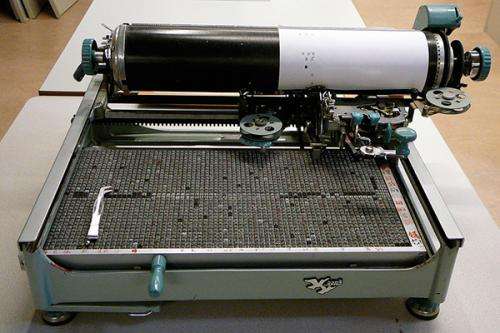Chinese typewriter anticipated predictive text, finds historian

(Phys.org)—By reorganizing the typewriter's characters into ready-made clusters of commonly used words, Mao-era Chinese typists solved problems that cell phones only came to recently.
For most Americans, predictive text is something cell phones do. From the T9 system on clamshell phones to autocomplete on smartphones, tough-to-type-on cell phones have been natural candidates for this kind of labor-saving input technology.
But in China, predictive text has been around far longer – since Mao Zedong was in power more than 50 years ago, in fact.
Stanford history Associate Professor Thomas Mullaney is an expert – virtually the only expert – on the Chinese typewriter. Though viewed as little more than a joke in the West, the device is a remarkable engineering feat.
Chinese typewriters have no keys. Instead, the typist moves a character-selection lever over a tray bed filled with metal character slugs. The typist then presses a type bar, and the lever picks up the character, inks it, types it and returns it to its place.
But with upward of 2,500 characters crammed into the tray bed, simply locating the correct one could be a daunting task for early Chinese typists. And when they rearranged the tray bed to improve their typing speeds, these workers happened to anticipate many of the advances of modern text prediction software.
"Input issues that we're dealing with now are questions that China was thinking about in the mid-20th century," said Mullaney.
His research, excerpted from his forthcoming book, "The Chinese Typewriter: A Global History," appeared this week in the journal Technology and Culture.
Efficiency standards
From the start, there were predictive aspects to Chinese type. The moveable type racks used in printing presses were organized roughly according to how commonly the characters were used. More common characters were placed close to the typesetter, less common characters were far away and especially unusual characters were kept in separate cabinets.
Within these sections, however, characters were arranged according to their dictionary order. This method was logical but inefficient. When it carried over to typewriters, Chinese typists were only able to manage 20 to 30 characters a minute, versus more than 60 words per minute for American secretaries.
And when the communists came to power, typists got busy.
"From the '50s onward, China was in a state of more or less perpetual political campaigns," said Mullaney. "The burden for a lot of this fell on typists."
Typists were responsible for reproducing the waves after waves of speeches, pamphlets and other political materials that accompanied massive communist efforts to reshape the country.
In this unique social climate, the announcement that one Zhang Jiying had managed to set more than 50 characters a minute garnered major media attention.
The feat made headlines in the People's Daily, the official party newspaper, and was quickly raised up as a model of communist innovation and efficiency. The typesetter drew film crews, took part in parades, coauthored typesetting manuals and toured nationally.
The record-setting accomplishment, which Zhang later bettered to nearly 80 characters a minute, was due to his revolutionary character arrangement.
Most typesetters customized their character racks in one way or another, but Zhang had reorganized his into "natural-language clusters" – grouping Chinese characters that tended to appear together in sentences.
This meant that Zhang would reorganize his characters every time a new political campaign started up. During the Korean War, for instance, Zhang would prepare phrases like "Resist America, Aid Korea." When the government was emphasizing worker efficiency, he might prepare the character combinations for "production" and "labor."
Evolving keyboard
As the new method was applied to the typewriter, the resulting character arrangements reflected major shifts in the Chinese language.
The increasingly predictable language of communism made the job of predicting language significantly easier. Stock phrases and standardized terminology – seen in the dissemination of politically significant words like "struggle" and "proletariat" – are partially responsible for the success of the new approach.
Mullaney pointed out that one could trace the changing fortunes of characters as they move around the typewriter. The character mao, for instance, once a second-tier term for "hair" during the 1930s pre-communist era, won a central position as soon as Chairman Mao took power.
On the other hand, the limited number of characters that could be fit onto a standard Chinese typewriter meant that rarely used characters increasingly fell out of favor.
Although the typewriter fell out of favor with the adoption of the computer, Chinese text input remains heavily dependent on prediction.
Chinese computers typically use QWERTY keyboards. "If you were to look over someone's shoulder who's typing in Beijing," said Mullaney, "you might think it's just like ours. But Q doesn't mean Q."
Typing a key may lead to a character selection window – much like typing a text message on a cell phone, in which each number key represents a variety of possible letters. Or sequences of several keys may code for a single Chinese character.
This extra layer of input makes cell-phone-style predictive text a basic part of all Chinese word-processing software.
"Predictive text isn't widely used here beyond cell phones," said Mullaney. "In China, it is the way you write."
More information: Mullaney, T., The moveable typewriter: how Chinese typists developed predictive text during the height of Maoism, Technology and Culture, October 2012. muse.jhu.edu/journals/technolo … e/toc/tech.53.4.html
Provided by Stanford University
















